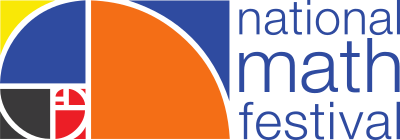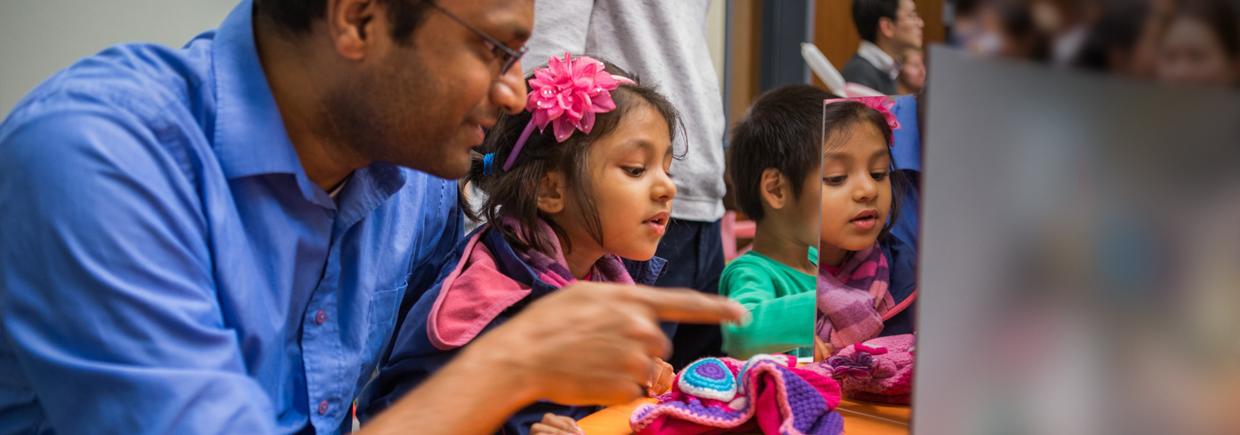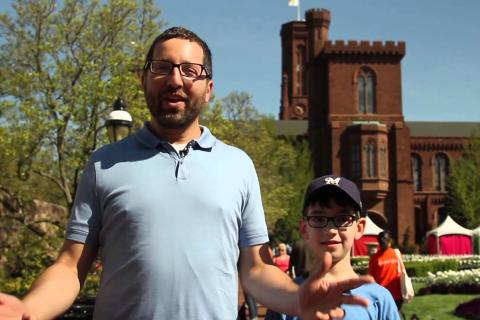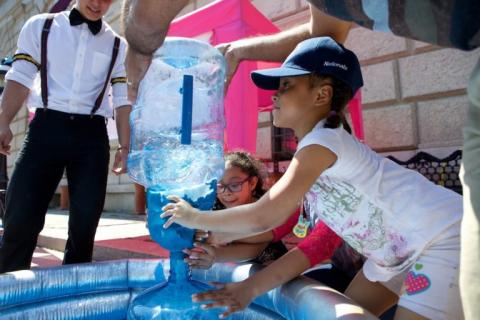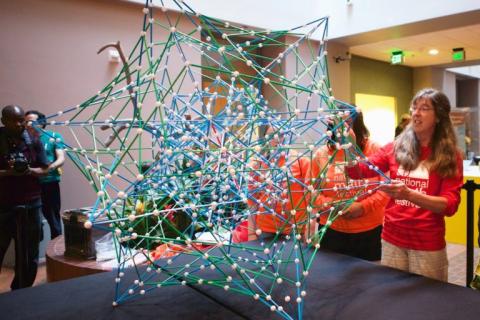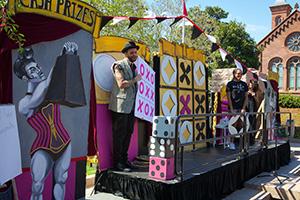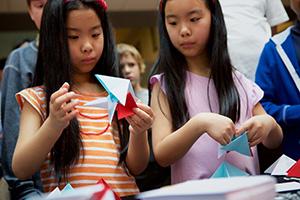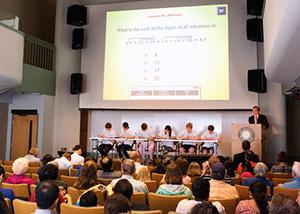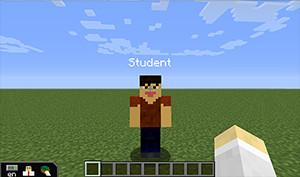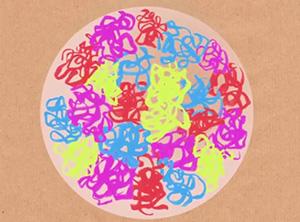2015 Festival
On Saturday, April 18, 2015, more than 20,000 people in Washington, D.C. experienced math as never before at the first-of-its-kind National Math Festival. This public celebration featured more than 70 activities for every age—from hands-on magic and Houdini-like getaways to lectures with some of the most influential mathematicians of our time!
2015 Festival Highlights
The Mathematical Sciences Research Institute and the Institute for Advanced Study presented this free, all-day event in cooperation with the Smithsonian Institution. We outgrew our venue very quickly that day!
View the 2015 Festival Schedule (PDF) (opens new window)
2015 Festival Featured Events
Cash Prizes for Everyone! (Guerilla Science)
“Cash prizes for Everyone!” is an interactive game-show that offers the audience a chance to win big! In front of a large crowd, competitors (drawn randomly from the audience) will be invited to compete against a performing mathematician in one of a number of solved games. Huge prizes offered to anyone who can beat the house!
Geometric Origami (Bridges Organization)
In this building workshop, we are making Platonic solids: a dodecahedron and an icosahedron, decorated with geometric patterns. The dodecahedron has 12 faces and 20 vertices, while the icosahedron has 20 faces and 12 vertices! You will also assemble a colorful, mathematical origami octahedron. These beautiful objects can become necklaces to be worn and taken home.
Who Wants to Be a Mathematician? (American Mathematical Society)
In the American Mathematical Society contest “Who Wants to Be a Mathematician”, area high school students will compete by answering multiple choice mathematics questions in a competitive and entertaining quiz show format. The top prize is $3,000!
The Math Behind Minecraft (Joel Levin, TeacherGaming)
Video games in the classroom? Certainly! Math and science teachers are using Minecraft to build worlds, solve problems, and have fun with their students. Join “The Minecraft Teacher” as he takes kids and adults on a guided tour of the Edu version of the game, showing off past problems and solving a few together on the spot.
Knots and DNA (Dr. Mariel Vazquez, University of California, Davis)
“The best thing about being a scientist is the fun you have. Math is fun. I use math and computers to tackle scientific problems dealing with DNA. In my work I get to draw a lot of pictures. I play with rope and with ribbons,” says Dr. Mariel Vazquez. Most cells in your body have two meters of DNA in them. DNA molecules inside a confined environment such as the cell nucleus, just like your headphones in your backpack, tend to intertwine and tie knots. Hear about how these knots present a “packing problem,” and the mathematical and computational tools used to tackle it.
Rubik’s Cube and Other Permutation Puzzles (Dr. Matthew Kahle , The Ohio State University)
Permutation puzzles in one form or another have been around for at least 140 years. The Rubik’s cube is perhaps the most popular permutation puzzle of all time. These puzzles have a visceral appeal, and they have provoked many fascinating new mathematical questions. Over 30 years after the initial Rubik’s cube craze, people are still discovering new things—last year for example, Tomas Rokicki and Morley Davidson spectacularly proved that “God’s number” for the Rubik’s cube is 26, meaning that every cube, no matter how scrambled, can be solved in at most 26 moves.
Around the U.S. - Museums Celebrate the 2015 Festival
On Saturday, April 18, 2015, more than 80 museums in 33 states offered Zometool (opens new window) Bubble Station demos to celebrate the 2015 Festival in partnership with the Association of Science – Technology Centers (ASTC). Zometool is a construction set that allow players to build beautiful and fascinating models from simple to profound. In fact, NASA has used Zometool for AIDS virus research in space and for a space station project! And the bubbles? Why, they’re soap bubbles, of course – but with a geometric twist.
Can you imagine using a bubble wand and dish soap to make a square bubble? How about a cubic, spiral, saddle-shaped, wormhole, or parabolic-shaped bubble? With the Zometool Bubble Stations, everyone from young kids to grown-up mathematicians will find delight in exploring how the principle of “minimal surfaces” makes possible not just the round soap bubbles we all know from our childhoods, but—with differently shaped Zometool “bubble frames”—geometric soap bubbles of many surprising forms.
Participating museums included:
Alabama
- Gulf Coast Exploreum – Mobile
- Hardin Center for Cultural Arts – Gadsden
- Sci-Quest Hands on Science Center – Huntsville
California
- Children’s Creativity Museum – San Francisco
- Explorit Science Center – Davis
- Lawrence Hall of Science – Berkeley
- Lori Brock Children’s Discovery Center – Bakersfield
Colorado
- Fort Collins Museum of Discovery – Fort Collins
Florida
- Gillespie Museum, Stetson University – DeLand
- Museum of Science and Industry – Tampa
- Orlando Science Center – Orlando
- Patricia and Phillip Frost Museum of Science – Miami
- Pensacola MESS Hall – Pensacola
- South Florida Science Center – West Palm Beach
Georgia
- Fernbank Science Center – Atlanta
- The Museum of Arts and Sciences – Macon
Idaho
- Discovery Center of Idaho – Boise
Illinois
- Children’s Discovery Museum – Normal
- Children’s Museum of Illinois – Decatur
- Discovery Center – Rockford
- SciTech Hands on Museum – Aurora
Indiana
- Carnegie Museum – Crawfordsville
- Minnetrista – Muncie
- Science Central – Fort Wayne
- Terre Haute Children’s Museum – Terre Haute
- The Children’s Museum of Indianapolis – Indianapolis
- WonderLab Museum – Bloomington
Kansas
- Exploration Place – Wichita
Kentucky
- Owensboro Museum of Science and History – Owensboro
- The Living Arts & Science Center – Lexington
Massachusetts
- EcoTarium – Worcester
- Springfield Museums – Springfield
Maryland
- Rockville Science Center, Inc. – Rockville
Maine
- Children’s Discovery Museum – Augusta
Michigan
- Michigan Science Center – Detroit
Minnesota
- Headwaters Science Center – Bemidji
- The Works Museum – Bloomington
Mississippi
- INFINITY Science Center – Pearlington
- Mississippi Children’s Museum – Jackson
North Carolina
- Cape Fear Museum of History and Science – Wilmington
- Catawba Science Center – Hickory
- Port Discover – Elizabeth City
- SciWorks – Winston-Salem
Nebraska
- Edgerton Explorit Center – Aurora
- University of Nebraska at Omaha – Omaha
New Hampshire
- McAuliffe-Shepard Discovery Center – Concord
- SEE Science Center – Manchester
New Jersey
- Garden State Discovery Museum – Cherry Hill
New Mexico
- E3 Children’s Museum and Science Center – Farmington
Nevada
- Las Vegas Natural History Museum – Las Vegas
New York
- Buffalo Museum of Science – Buffalo
- CNSE Children’s Museum of Science & Technology – Troy
- Mid-Hudson Children’s Museum – Poughkeepsie
- miSci – Schenectady
- New York Hall of Science – Corona
- Sciencenter – Ithaca
- Science Discovery Center – Oneonta
- Sci-Tech Center of Northern NY – Watertown
- Staten Island Children’s Museum – Staten Island
- Tesla Science Center at Wardenclyffe – Shoreham
Ohio
- Science Play-Space Initiative, SPI – Mount Vernon
- Imagination Station – Toledo
Oregon
- Oregon Museum of Science and Industry – Portland
- Science Factory Children’s Museum & Exploration Dome – Eugene
Pennsylvania
- Carnegie Science Center – Pittsburgh
- Discovery Space – State College
- The Franklin Institute – Philadelphia
South Dakota
- South Dakota Discovery Center – Pierre
Tennessee
- Adventure Science Center – Nashville
- Discovery Center at Murfree Spring – Murfreesboro
Texas
- Children’s Museum of Houston – Houston
- Hill Country Science – Johnson City
- Mayborn Science Theater – Killeen
Virginia
- Science Museum of Western Virginia – Roanoke
- Ideaventions – Oakton
- Children’s Museum of Virginia – Portsmouth
Washington
- KidsQuest Children’s Museum – Bellevue
Wisconsin
- Children’s Museum – La Crosse
- Madison Children’s Museum – Madison
- The Paper Discovery Center – Appleton
Wyoming
- Lander Children’s Museum – Lander
